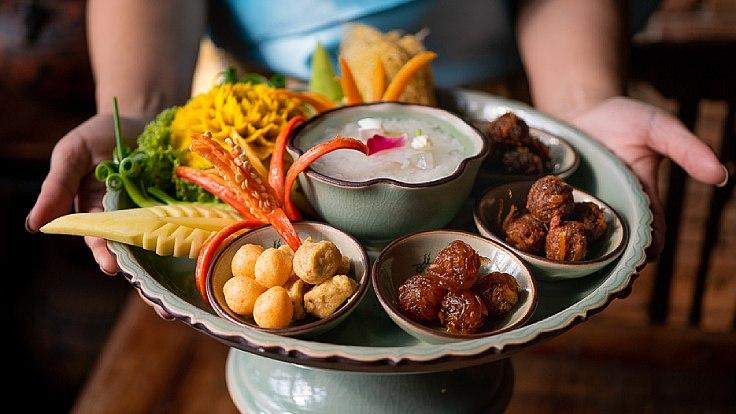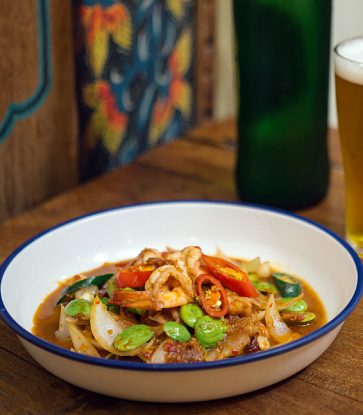The soaring summer temperatures in Thailand signal “khao chae” season. Featuring fragrant, chilled rice, this dish is a lovely way to cool down while celebrating Thai traditions, and learning to create khao chae and its accompaniments helps preserve a cherished facet of the Thai culinary arts.
“Khao chae began as a local delicacy among the Mon people. It was used to worship the gods during the Songkran new year celebrations,” said Chomploy “Palm” Leeraphante, the daughter of Ajarn Mallika and Chief Operating Officer of Ruen Mallika (The Plate, MICHELIN Guide Thailand 2020). “The dish was then considered more for aristocrats, but eventually this traditional meal reached people nationwide. In Thailand, khao chae is divided into ‘khao chae chao baan’ (for commoners) and ‘khao chae chao wang’, or ‘khao chae savoey’, (for royalty).

"The ‘commoner’ version uses rainwater cooled in clay pottery and comes with side dishes that vary according to the region. The royal khao chae is known for its fragrant water and use of ice, which, in the past, had to be imported from Singapore. Typically, royal khao chae accompaniments are sweetened fried meats served with intricately carved vegetables.”
Ruen Mallika’s khao chae ingredients come from Suan Saranphan, a 48-rai organic farm in Lopburi Province, and the rice is an organic jasmine variety picked mid-year when it is most fragrant. The accompanying dishes are also varied. Instead of snakehead fish, the kapi balls are made with sweet catfish meat, and salted duck eggs are served alongside the shredded pork and beef.
Creating khao chae in your home kitchen requires patience and practice. Nevertheless, mastering this traditional speciality is very rewarding. The following are a few recipes adapted for home cooking by Ajarn Mallika of Ruen Mallika.

Khao Chae Chao Wang (Royal Thai Khao Chae)
Khao Chae
Add jasmine rice to boiling water. Once the rice is half cooked, remove from heat and strain out the water. Rinse the rice under running water, washing the grains with your hands until the water runs clear. Return the rice to the cooker with fresh, clean water and cook under medium heat until done. When finished, place the rice in a pot (clay preferred) and leave to cool. Light a traditional Thai Scented Dessert Candle (tien ob) in an open container within the clay pot and cover.
Jasmine Scented Water
Boil water in a pot, then remove from heat. Place a tien ob in an open container inside the pot and light the candle. Add jasmine flower buds to the water, cover the pot, and wait for the water to cool.

Kapi Stuffed Shallots
Ingredients:
Shallots
200 grams - Thai fingerroot
1 catfish
100 grams - coriander root
100 grams - onion
100 grams - large garlic cloves
200 grams - palm sugar
100 grams - shrimp paste (kapi)
1 egg and wheat flour to coat.
Instructions:
1. Cut the fingerroot into small pieces then clean and debone the catfish. Pound or blend together into a smooth paste. Set aside.
2. Chop and crush coriander roots.
3. Peel garlic, chop into small pieces.
4. Chop and cut lemongrass into small pieces and blend.
5. Peel onions, chop into small pieces and blend.
6. Combine all ingredients in a pan over low heat. Stir in shrimp paste and palm sugar until sticky enough to be moulded into balls.
7. Cut a small hole in the centre of a medium sized shallot. Stuff with the cooked shrimp paste mixture. Coat with wheat flour.
8. Heat a pan with oil to medium heat.
9. Beat one egg with flour and dip stuffed shallots in before frying.
10. Fry until the shallots are golden.

Stuffed Green Banana Pepper in Egg Lace
Ingredients:
100 grams - minced pork
2 shrimps
2 teaspoons granulated sugar
1 tablespoon fish sauce
1 tablespoon Thai seasoning sauce
Coriander root
Garlic
Pepper
Green banana pepper
Coriander for garnish
Instructions:
1. Cut open a banana pepper lengthwise and scrape out seeds and membrane.
2. Peel and chop shrimp. Add to minced pork.
3. Chop meat mixture together with coriander root, garlic, pepper, and add sugar, fish sauce and seasoning sauce and mix well. Add the small pieces of coriander and stuff into the pepper.
4. Microwave mixture on medium heat for 2 minutes (or steam for 15 minutes) and set aside.
5. Beat 2 eggs together. Heat a pan with oil, then use all fingers to splatter beaten eggs in a criss-cross pattern onto the hot oil.
6. When the egg lace is cooked, remove from heat and wrap around the stuffed banana pepper.

Fried Salted Egg
Ingredients:
Salted duck Egg
Palm sugar
Wheat flour
Chicken eggs
Vegetable oil
Instructions:
1. Peel the salted duck egg and remove the yolk.
2. Mix the yolk with a pinch of palm sugar.
3. Roll the yolk into the size of a pea eggplant and coat with wheat flour.
4. In a deep pan, add oil and heat.
5. Beat chicken eggs and add wheat flour. Coat the duck egg balls in this mixture before frying.
6. Fry until golden brown before removing from the oil.

















